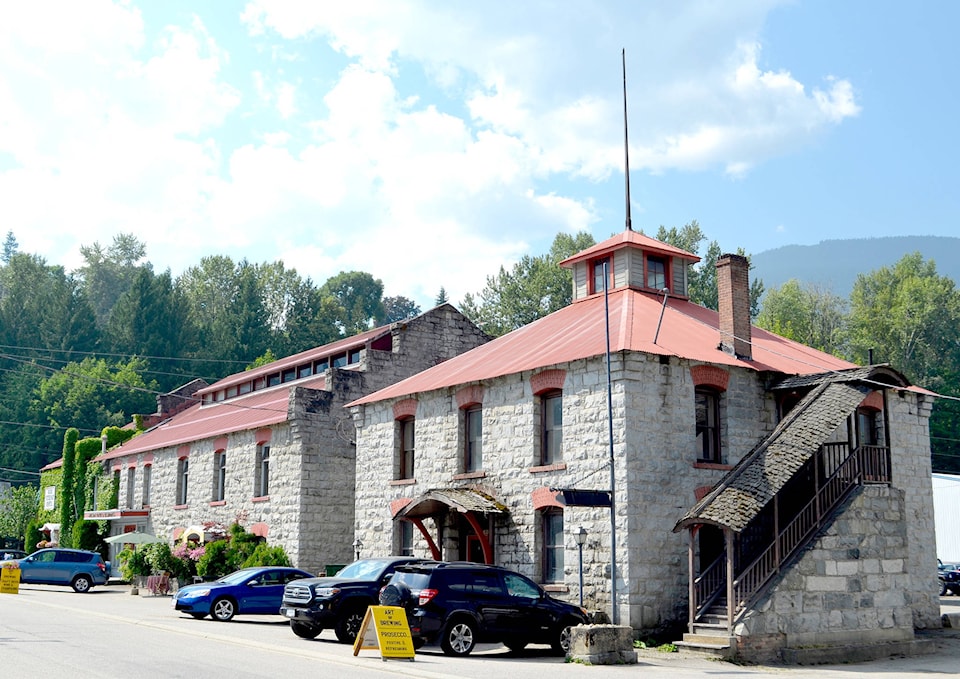Mayor Deb Kozak thinks the currently vacant gasworks building in Railtown could make an ideal office for innovators in the tech sector, and could just as easily be an art gallery or a retail space — it’s just looking a little worse for wear at the moment, and needs some sprucing up.
“Nelson has quite a few heritage buildings, and this one is especially important because it will help us retain the gritty industrial heritage of Railtown,” she told the Star.
“The coke and gasworks building will play a key role in how our development of Railtown plays out, and at this point we’re protecting and holding it until we can do the work on the building envelope and the foundation, and preserve it properly.”
That will happen now that the building has been named one of the recipients of the Columbia Basin Trust’s Built Heritage fund, which aims to support communities in preserving their historical architecture.
It will receive $100,000 that will go towards a thorough facelift.
Revitalizing Railtown, again
The City of Nelson purchased the building in 1910, running it until 1948, when it sold its distribution system to the Inland Natural Gas Company. Shortly after that it became a depot for buses.
When designer Bob Inwood was enlisted to spearhead the revitalization of Nelson in the late 1970s, it was the gasworks building that he used as a test case.
His crews replaced the staircase, put a new roof on it and gutted the inside, reconstructing entranceways and incorporating some aesthetic flourishes.
But that was all over 40 years ago — and driving by it these days, Inwood feels disappointed that the building has been neglected for so long.
“This is pretty typical with city properties, but it hasn’t been well maintained over the years. Elements that were part of the restoration process themselves are now falling into serious disrepair,” Inwood told the Star.
That includes the staircase along the side.
“I’m hoping whatever work ends up getting done is going to be sympathetic to the structure. It’s really one of the anchors of the Railtown area, and it’s got some fascinating history associated with it.”
‘A cornerstone of Nelson for years to come’
Historian Greg Nesteroff agrees with Inwood that the structure is deserving of the funds, especially when considered in its current context — historic Fortis buildings in South Slocan are being demolished, much to his dismay.
He noted the gasworks building is in the city’s heritage register.
“The neat thing is that along with the CPR building, it’s a reminder of Nelson’s industrial heritage, which sometimes gets short shrift.”
According to the register, the gasworks building owned by the city and its neighbours “are important for being one of the earliest examples of community-led heritage conservation … These buildings were the first two voluntarily designated heritage structures in the city.”
Processing 600 pounds of coal scrap
The red-roofed stone building, which is situated next to two other stone buildings that house the Art of Brewing and the Nelson Animal Hospital, was first constructed in 1910 as an administration office for a business that made coke, tar, creosote and paint.
It supplied Nelson with coal gas until 1957, when the plant closed down.
(Coke, by the way, is the name for a byproduct of gas manufacturing that was used as a smokeless fuel.)
According to an article from local magazine Heritage West, the daily gas-making process involved taking 600 pounds of coal scrap delivered from a railroad spur into the building at the end of the street and feeding it into eight ovens on-site. Four-person crews then baked the coal for eight hours.
“The fumes from the heated coal rose and were piped into a 10-inch diameter main pipe, which ran suspended high on the wall into the second (Purifying) building,” it reads.
“In this section the raw gas was pumped through a series of large tanks, each designed to alter its composition.
“The vapours passed first through a series of condensing tubes, then into a tar extractor.”
Next up the liquid residue flowed into four circular stone tarpits in the complex’s backyard before going through two scrubber tanks that removed naphthalene content.
This gas became a lot less useful with the invention of electricity, but it was used for lighting streetlamps and heating homes. Some residents, though, had other ideas for what to do with the gas.
There was a control valve and faucet at the end of the process, and residents suffering from whooping cough were known to come down and inhale the vapours, which reportedly created a “miraculous curative effect.”
-With files from Greg Nesteroff
